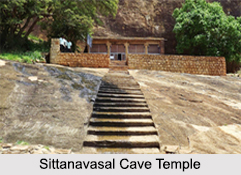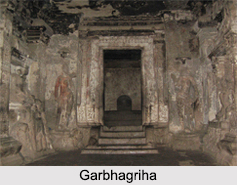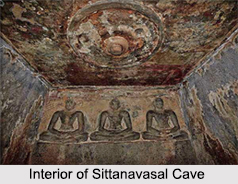 The Sittanavasal Cave in Tamil Nadu contains some of the most striking ancient cave paintings in India. Located in Pudukottai district of Tamil Nadu, Sittanavasal Cave is mainly a Jain temple cut in rock that was made in the 7th - 9th Century AD. There are gorgeous paintings on the ceilings of the cave which are well preserved. The quality and technique of the artwork is among the finest that is found in other caves in India. The paintings in this rock-cut Jain temple are made in the fresco technique. Sittanavasal Cave is situated on a cliff of 70 metres high rock surface.
The Sittanavasal Cave in Tamil Nadu contains some of the most striking ancient cave paintings in India. Located in Pudukottai district of Tamil Nadu, Sittanavasal Cave is mainly a Jain temple cut in rock that was made in the 7th - 9th Century AD. There are gorgeous paintings on the ceilings of the cave which are well preserved. The quality and technique of the artwork is among the finest that is found in other caves in India. The paintings in this rock-cut Jain temple are made in the fresco technique. Sittanavasal Cave is situated on a cliff of 70 metres high rock surface.
History of Sittanavasal Cave
The Sittanavasal village is dated from 1st century BC to 10th century AD. Jainism flourished here. The Temple-cave was initially dated to Pallava King Mahendravarman I (580–630 AD). However, an inscription justifies its renovation to a Pandyan king probably Maran Sendan (654–670 AD) or Arikesari Maravarman (670–700 AD). The Jain beds on the hill top suggest the existence of Jain pilgrimage centre which lasted till the 9th century AD.
Eladipattam
Eladipattam, another rock shelter located to the south of Sittanavasal was used as a Jain shelter from 1st century BC. The interiors of the cave contain seventeen stone compartments, which are polished and set in rows; there are rock structures that appear as beds. Those were used by the Jain monks. There are inscriptions in Tamil language, Brahmi script, and they mention the names of various monks like Tiruppuranan, Nityakaran Pattakali, Tirunillan, Tolakunrattu Kadavulan, Tittaicbaranan and others. Eladipattam was majorly used for practice of Kayotsarga, a meditation on foot and Sallekhana, which is basically fasting till death.
 Arivar-Koil
Arivar-Koil
Arivar-Koil temple, the shrine of the Arhats, is located on the north-western part and was created during 7th - 9th Century AD. The front part is basic and simple and has four pillars, but this structure was constructed in the 20th century, inspired by the architecture of other monuments. There is a front yard and a hallway, Ardha mandapam, and also consists of a cell, Garbha Graham, in the back. There are Tamil inscriptions on right portion. These inscriptions are about Ilan-Gautaman, a Jain mendicant. The Ardha Mandapam is 7metres in width and more than 2metres in depth. There is an image of Jain guru, Acharya on the right side and another image of Parsvanatha on the left. The garbha graham, a chamber, contains paintings on the ceiling. There are stunning artworks of ancient era on the ceiling of the hallway and on the pillars. Historian S. Radhakrishna Iyer discovered the temple and the paintings, and mentioned his findings in his book.
Frescoes in Sittanavasal Cave
The paintings were mostly made during the Pandyan period, in the 9th century AD. The most vital artwork is that of a pond blooming with lotus; while monks and other animals in the pool gather flowers. This is the portrayal of the Samava-sarana, which is considered holy by the Jains. Upper parts of pillars also contain paintings of a royal couple and Apsaras holding lotus. Even though, the colours have faded, it is evident that the method of painting is rather developed. The walls of the caves are unevenly plastered. The initial coating was made with sand, while the next layer was smoother. The plasters are coloured and are still preserved. Most of the colours are orange, white, yellow, blue, green and black. However the paintings have been affected by natural forces.
 Garbhagriha at Sittanavasal Cave
Garbhagriha at Sittanavasal Cave
The Garbha graham is a quadrangular chamber, with a width of 3m and a height of 2.3m, and there are sculptures of Thirtankaras and an Acharya on the back wall. There is a carving of Dharma chakra, the wheel of law, on the ceiling, which also consists of frescoes and a depiction of Samava-sarvana, a pond with lotus.
The region of Sittanavasal is a vital ancient Jain site, and there are numerous fascinating monuments of Hindu and Jain religions. The walls of the rock face of the temple are ornamented with carvings of Jain Thirtankaras. In the region between Arivar-Koil and Eladipattam there is a temple of Navach-chunai, which is now sunken under a lake. This is a temple of Lord Shiva accompanied by a lingam. Towards the west of Sittanavasal hill, a shrine of deities is located that has intricate works of terracotta horses. There are many other ancient structures and monuments in the region that are of great value.




